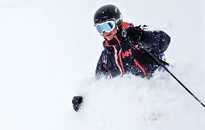On the chairlift, at après-ski or sometimes through the magazine, I’m often asked medical questions beyond what I typically attend to in a big-city E.R. Here are a few that have surfaced more than once.
Why does my friend Errol fart so much when he skis?
Increased flatus at higher elevations is a phenomenon called high-altitude flatus expulsion, or HAFE, which was first described in a medical journal in 1981. During a relatively quick rise in elevation, the pressure of the gas in our intestines increases in relation to dropping air pressure, which causes the gas in the rectum to expand. If you’re wearing windproof ski pants, you may be the only one who notices HAFE. Perhaps you should suggest to Errol a destination that offers more drag lifts and fewer gondolas and cable cars.
Why do my daughters take so many pee breaks during family ski trips? Are they trying to slow me down on purpose?
Increased pee breaks could be from the hotel’s self-serve latte machine or it could be due to a phenomenon called cold diuresis. As the core body temperature falls, blood is moved away from our extremities to our core in order to preserve heat. Our body still has the same amount of blood, though, just now it’s in a smaller space. The kidneys (located in our core) filter out excess fluid to reduce the blood’s volume and this likely results in more stop-and-go for your team.
Is it true that eating snow when you’re thirsty causes more dehydration?
This common belief is a medical myth, based on the fact that melting snow in your mouth drops your body temperature. And to maintain our body temperature, we need to burn calories, which requires water. While all of this is true, the metabolic math doesn’t add up. More water is absorbed by eating snow than is used when heating the body. So the next time you’re thirsty and your water bottle is empty while slogging uphill in the backcountry, feel free to eat snow. I’d still avoid yellow snow, though.
Why do I feel like passing out or at least light-headed when I bend over to buckle up my ski boots?
Your dizziness is likely due to a temporary drop in your blood pressure and a corresponding lack of blood flow to the brain. Part of this drop in blood pressure occurs because, while you’re bent forward, the main vein that returns blood to your heart (the inferior vena cava) is compressed. This results in less blood filling the heart’s pumping chambers, which drops your blood pressure. To avoid this uncomfortable feeling, try sitting down on a bench at the top of the lift while you buckle up.
Why does my nose run so much when I ski?
Apart from helping hold your goggles in place, your nose is responsible for heating the cold air you breathe in before it gets to your lungs. To do this, the blood vessels that line your nasal cavity must dilate to deliver more warm blood. As those vessels dilate, water leaks out of the blood vessels, which leaves you with a runny nose.
Can my tongue really get stuck to a freezing chairlift pole?
Definitely. Since metal is a better conductor of hot/cold than your tongue, the water on your tongue freezes quickly, gluing your porous tongue to the pole. If you pull your tongue away before thawing the now-frozen spit, you will leave part of your tongue behind on the pole. This is a painful injury that bleeds a lot and will likely cut your ski day short. Several methods for melting a frozen tongue off a chairlift pole include warming the cold metal with your breath, using warm (dry) hands to heat the metal or pouring a warm liquid over the point of contact. There are even case reports of people resorting to using warm urine; maybe leave that method as a last resort.

Dr. John Foote is an emergency room physician at Toronto’s Mount Sinai Hospital and a Devil’s Glen skier.



